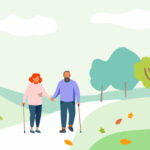In honor of UV Safety Month, I thought it was appropriate to spread awareness of harmful UV rays as many dash to the beach. We’ve all heard the cautions about the sun’s harmful rays, but I have to admit, I didn’t know this:
Having five or more blistering sunburns early in life increases one’s melanoma risk by 80%.1
Let’s review some facts:
A Trifecta of Radiation
The sun emits its energy as invisible, ultraviolet (UV) radiation. Overexposure of these rays on unprotected skin cause temporary and permanent damage. There are three types of UV rays:2
|
UVA
UVA rays have the least energy, but can cause long-term damage to skin cells such as aging (wrinkles) and some skin cancers. |
UVB
UVB rays can damage skin cells’ DNA and cause sunburns and most skin cancers. |
UVC
UVC rays have the most energy and don’t reach our atmosphere naturally. They are also seen in man-made sources, such as UV sanitizing bulbs used to kill germs. |
UV rays can cause damage even on cloudy/overcast days and are strongest:3, 4
- Between 10 a.m. – 4 p.m.
- During the spring and summer months
- Near the equator
- At high altitudes
- Reflecting off surfaces (e.g. water, sand, snow, pavement)
Effects of Harmful UV Rays
Serious damage from harmful UV rays can cause different types of skin cancers:
|
Overview |
Basal and Squamous Cell Skin Cancer5
The most common form, this cancer starts growing in the top layer of the skin (epidermis) and is diagnosed in 3.3 million Americans annually. |
Melanoma
Skin Cancer6 This is a less common, but more dangerous skin cancer because it spreads easily. Rapidly rising over the decades, it is estimated that close to 7,000 Americans will die of melanoma in 2020. |
Merkel Cell
Skin Cancer7 A rare skin cancer, MCC is hard to treat if it spreads beyond the skin, making it one of the most dangerous types. Out of 2,000 cases diagnosed each year in the U.S., 4 out of 5 are over age 70. |
|
Risk Factors |
|
|
|
|
Treatment Options |
|
|
|
While people with light skin are at a higher risk for UV damage, the skin and eyes of all ethnicities can be affected. When the skin absorbs UV rays, it releases more melanin, a brown pigment that causes the skin to “tan” or sunburn. But UV exposure can raise skin cancer risk even without causing sunburn. Likewise, some medications can increase your skin’s sensitivity to light, increasing your cancer risk.8
The UV Index
Developed by the EPA and National Weather Service, a higher number equals greater risk of UV exposure:

Protection from Harmful UV
Avoiding sunlight is not always practical to keep yourself protected from harmful UV rays. Plus you may want to absorb some rays responsibly so your body can make Vitamin D. (Note: always check with your healthcare practitioner to see what is right for you). So, here are some tips to keep you safe while outdoors this summer:10
- Shade Your Skin… out of the sun and/or with pants/long-sleeved shirts [look for UV Protection Factor (UPF) values on the labels]. Being sheltered doesn’t necessarily mean you’re shaded (beware of windows).
- Slather the Sunscreen… with broad spectrum, water resistant, and a Sun Protection Factor (SPF) more than 30. My favorites contain zinc oxide and titanium dioxide as active ingredients. Sunscreen should be applied 30 minutes before sun exposure to thoroughly absorb into the skin, offering fullest protection. Don’t forget to check expiration dates and reapply every couple hours – more often if you’ve swam or sweat.
- Wear a Hat… with a 2-3” brim all around and a dark, non-reflective underside. Straw hats are not effective here. If you don’t have a hat or a shade cap, drape a large hanky/bandana under a baseball cap to protect the back of your neck/ears.
- Sport those Shades… with large-framed or wraparound sunglasses that absorb UV up to 400 nm and/or meets ANSI UV requirements. You may see these sunglasses advertised as “UV 400 protection” or “100% protection against UVA & UVB.” The skin around the eyes is very delicate and long sun exposure can lead to certain eye diseases.
- Scrutinize Your Skin… with monthly self-examinations and annual skin examinations by your healthcare practitioner to help identify melanoma early.
- Avoid Tanning Beds… and sun lamps, period.
Tanning Alternatives11
Many alternatives to sunbathing have been introduced, but not all are considered safe. Even when using these alternatives, it’s important to still apply sunscreen when outside for an extended period of time.
|
SAFE
Bronzers, including tinted moisturizers and brush-on powders are made from FDA-approved color additives for cosmetic use. They are meant to be temporary and washed off. Sunless/Self-tanning Lotions commonly contain the FDA-approved color additive DHA and tends to wear off after a few days. Tanning Sprays, used both at home and by salons, containing DHA are not approved as an inhalant and should protect the mouth, eyes and nose when using. |
ARE NOT/MAY NOT BE SAFE
Sunless Tanning Pills contain canthaxanthin (approved by the FDA as a food coloring only). The typical dose recommended by tanning pill manufacturers may be toxic, which may impair vision, skin and liver function. Tanning Accelerators with tyrosine have not shown to be effective and may be dangerous. They are not approved by the FDA. |
Now that you have the facts, let’s turn back to Michelle, Jenn and the teens. We know it was smart of them to bring a beach umbrella, sunglasses and sunscreen, but where did they go wrong? Can they turn it around?
“Oh barnacles,” Jenn said, disappointed. “We only brought SPF 15.”
“No good?” asked Michelle.
“Well, I know that no sunscreen protects you completely, but I meant to grab at least a 30 broad spectrum. That filters out about 97% of UVB and UVA rays, versus 93% of UVB only,” explained Jenn. “That’s okay, we’ll just need to make sure they re-apply it more often. Every 30 minutes in the sun with just SPF 15 is the same as getting 2 minutes of UVB rays unprotected. WAIT! They haven’t applied at all yet! Kids…!” Jenn hollered.
Michelle grabbed her wallet and rose.
“Where are you going?” Jenn asked.
“If we didn’t remember they needed to lotion up 30 minutes before we got out here, we’re not going to remember to remind them every half hour! I’m off to find a store along the boardwalk with more suitable sun protection.” Michelle tramped across the sand as they heard Madison squeal again… this time followed by a splash.
2American Cancer Society, “What is UV radiation?”
3CSun Safety Facts | Skin Cancer | CDCDC, “Sun Safety Tips for Families”
4American Cancer Society, “How Do I Protect Myself from UV Rays”
5American Cancer Society, “Basal and Squamous Cell Skin Cancer”
6American Cancer Society, “Melanoma Skin Cancer”
7American Cancer Society, “Merkel Cell Skin Cancer”
8American Cancer Society, “Be Safe in the Sun”
9US Environmental Protection Agency, “UV Index Scale”
10American Cancer Society, “How Do I Protect Myself from UV Rays?”
11American Cancer Society, “Tanning Pills and Other Tanning Products”














